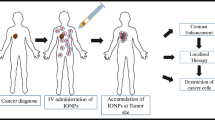Abstract
Smart magnetic resonance imaging (MRI) contrast agent has the ability to increase or decrease the signal intensity through response to certain analyte. Among the growing class of responsive agent, imaging probes based on gadolinium ion are developing fast in the last decade since they play an important role in physiological and pathology process in living system. This minireview would highlight recent progress in metal responsive gadolinium-based MRI contrast agent.
Similar content being viewed by others
References
Viswanathan S, Kovacs Z, Green K N, et al. Alternatives to gadolinium-based metal chelates for magnetic resonance imaging. Chem Rev, 2010, 110: 2960–3018
Aime S, Botta M, Fasano M, et al. Lanthanide(III) chelates for NMR biomedical applications. Chem Soc Rev, 1998, 27: 19–29
Que E L, Chang C J. Responsive magnetic resonance imaging contrast agents as chemical sensors for metals in biology and medicine. Chem Soc Rev, 2010, 39: 51–60
Lattuada L, Barge A, Cravotto G, et al. The synthesis and application of polyamino polycarboxylic bifunctional chelating agents. Chem Soc Rev, 2011, 40: 3019–3049
Pierre V C, Harris S M, Pailloux S L. Comparing strategies in the design of responsive contrast agents for magnetic resonance imaging: A case study with copper and zinc. Acc Chem Res, 2018, 51: 342–351
Caravan P, Ellison J J, McMurry T J, et al. Gadolinium(III) chelates as MRI contrast agents: Structure, dynamics, and applications. Chem Rev, 1999, 99: 2293–2352
Lauffer R B. Paramagnetic metal complexes as water proton relaxation agents for NMR imaging: Theory and design. Chem Rev, 1987, 87: 901–927
Sherry A D, Wu Y. The importance of water exchange rates in the design of responsive agents for MRI. Curr Opin Chem Biol, 2013, 17: 167–174
Aime S, Crich S G, Gianolio E, et al. High sensitivity lanthanide(III) based probes for MR-medical imaging. Coord Chem Rev, 2006, 250: 1562–1579
Peters J A, Huskens J, Raber D J. Lanthanide induced shifts and relaxation rate enhancements. Prog Nucl Magn Reson Spectr, 1996, 28: 283–350
Otting G. Prospects for lanthanides in structural biology by NMR. J Biomol NMR, 2008, 42: 1–9
Berridge M J, Lipp P, Bootman M D. The versatility and universality of calcium signalling. Nat Rev Mol Cell Biol, 2000, 1: 11–21
Li W, Fraser S E, Meade T J. A calcium-sensitive magnetic resonance imaging contrast agent. J Am Chem Soc, 1999, 121: 1413–1414
Dhingra K, Maier M E, Beyerlein M, et al. Synthesis and characterization of a smart contrast agent sensitive to calcium. Chem Commun, 2008, 57: 3444–3446
Waggoner D J, Bartnikas T B, Gitlin J D. The role of copper in neurodegenerative disease. Neurobiol Dis, 1999, 6: 221–230
Que E L, Chang C J. A smart magnetic resonance contrast agent for selective copper sensing. J Am Chem Soc, 2006, 128: 15942–15943
Jang J H, Bhuniya S, Kang J, et al. Cu2+-responsive bimodal (optical/MRI) contrast agent for cellular imaging. Org Lett, 2013, 15: 4702–4705
Lauffer R B, Parmelee D J, Dunham S U, et al. MS-325: Albumintargeted contrast agent for MR angiography. Radiology, 1998, 207: 529–538
Maret W. Zinc biochemistry: From a single zinc enzyme to a key element of life. Adv Nutr, 2013, 4: 82–91
Kim B J, Kim Y H, Kim S, et al. Zinc as a paracrine effector in pancreatic islet cell death. Diabetes, 2000, 49: 367–372
Myers S A, Nield A, Myers M. Zinc transporters, mechanisms of action and therapeutic utility: Implications for type 2 diabetes mellitus. J Nutr Metabol, 2012, 2012: 1–13
Kolenko V, Teper E, Kutikov A, et al. Zinc and zinc transporters in prostate carcinogenesis. Nat Rev Urol, 2013, 10: 219–226
Esqueda A C, Lopez J A, Andreu-de-Riquer G, et al. A new gadolinium-based MRI zinc sensor. J Am Chem Soc, 2009, 131: 11387–11391
Yu J, Martins A F, Preihs C, et al. Amplifying the sensitivity of zinc (II) responsive MRI contrast agents by altering water exchange rates. J Am Chem Soc, 2015, 137: 14173–14179
Author information
Authors and Affiliations
Corresponding authors
Rights and permissions
About this article
Cite this article
Zhang, L., Li, J. & Liu, K. Recent advances in gadolinium-based MRI metal responsive agent. Sci. China Technol. Sci. 61, 1329–1333 (2018). https://doi.org/10.1007/s11431-018-9315-7
Received:
Accepted:
Published:
Issue Date:
DOI: https://doi.org/10.1007/s11431-018-9315-7




